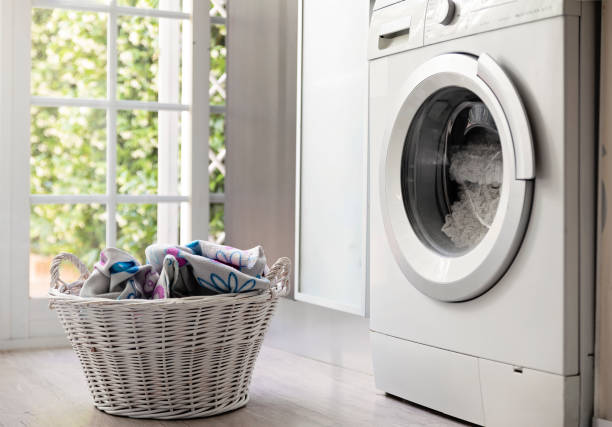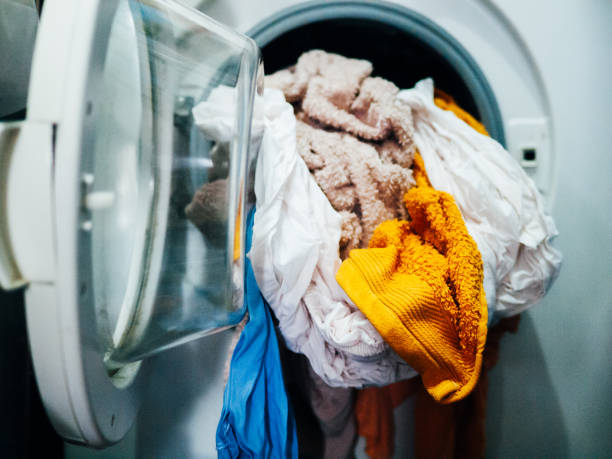Mold on the rubber gasket of front-loading washing machines is a common home concern. This type of mold is created by failing to clean the machine and/or utilizing it incorrectly. But don’t worry. In this post, you will discover how to remove mold from washing machines.

Just because a washing machine cleans clothing does not imply that it cleans itself. Mold thrives on the moisture and detergent residue left by the machine. With this in mind, here’s how to remove mold from washing machines and how to avoid it.
How to Remove Mold from Washing Machines
Rubber gaskets seal the watertight front doors, trapping moisture and creating pockets that can support mold and mildew growth. Because top-loading washers do not lock firmly, more air flows, preventing moisture buildup and mold formation.
Laundry detergent and fabric softeners can leave residue that serves as a food supply for mold spores, and cold-water washes do not eliminate mold development. Fortunately, regular maintenance may help you avoid mold in your washing machine and safeguard your investment.
Follow these steps to quickly and effectively clear mold from your washing machine:
- Remove the gasket.
Clear out the gasket. Clean the rubber gasket on the washing machine door with a cloth and hot, soapy water or mildew cleaner. Make careful to wipe the gasket on all sides, including underneath it. Before replacing the gasket, thoroughly rinse it and allow it to dry.
- Clean soap and softener dispensers.
Soap/softener dispensers should be cleaned. Remove the dispensers and thoroughly clean them to remove any residue that might act as a food source for mold. If your machine’s dispensers won’t come out, use a rag to wipe what you can reach and a bottle brush to clean deep inside the dispensers. Thoroughly rinse.
- Start a cleaning cycle.
Start a cleaning cycle. Run an empty washing cycle on your machine’s hottest, longest setting. It might have a machine cleaning or sanitizing setting. 1 cup bleach, 1 cup baking soda, 12 cup enzyme dishwashing detergent, or a commercial washing machine solution should be added immediately to the water.
If your machine hasn’t been cleaned in a long time, you may need to perform these procedures more than once to eliminate all traces of scents. If your moldy washing machine persists after numerous cleanings, you may want expert mold removal services. A repair technician can disassemble the equipment to check for and remove mold in additional spots.
How to Prevent Mold in Washing Machines
Once your washing machine is free from mold growth, take these preventative measures to keep it from coming back:
- Use just the appropriate detergent. Use High-Efficiency (HE) detergent if you have a HE washer. Non-HE detergent produces an excessive amount of suds, which promotes mold development. For the same reason, only use the prescribed amount of detergent.
- After each wash, leave the door open to enable moisture to escape from the machine. This avoids the establishment of a moist environment in which mold can flourish.
- Remove damp garments from the washer as soon as possible. This not only keeps moisture and mildew at bay, but it also keeps your garments from smelling musty.
- Wipe the door gasket with mildew cleaner on a regular basis. x Do this at least once a week to remove moisture and detergent residue that encourages mold development.
- If the location where you store the washer is humid, use a dehumidifier. Outside humidity may lead to mold growth within the machine, so make sure you address any water or humidity issues. Install a dehumidifier in the space.
Mold Prevention Tips for Washing Machines
- Use only a small quantity of washing detergent.
- Use liquid fabric softeners sparingly or not at all. Instead of using fabric softener, use distilled white vinegar in the dispenser to help eliminate soap residue and soften garments.
- Improve air circulation in your laundry room by installing a fan or air conditioner.
- Bring in a dehumidifier to reduce humidity levels.
- Examine your dryer vent to ensure it is not leaking damp air into the laundry area.
- Allow increased air circulation by leaving the door of a front-loading washer ajar after each load.
- Check that the fan in a front-loading washer is clean and functional, and that the vent is not obstructed.
- Run a cleaning cycle weekly, or monthly at the minimum.

The Most Effective Tips For Killing Mold And Bacteria
Here’s how to get rid of mold in your washing machine:
- Put on your gloves and get an old towel that you don’t care about.
- Create a solution of bleach and hot water OR vinegar and hot water. Never combine bleach and vinegar because it produces chlorine gas, which may be detrimental to your health.
- Soak the cloth in the solution and begin scrubbing away at any apparent mold. Make sure to get around the gaskets and the detergent dispenser.
- If there is a gasket around the door (front-load washers have these), clean and dry it well, including any folds.
- Use a cup of bleach or vinegar in a wash cycle on the hottest setting available on your machine. (No, not both!) Pour bleach into the bleach compartment if you’re using it. Pour vinegar into the detergent slot if using. You can utilize your machine’s self-clean cycle if it has one. This should eliminate any hidden mold that you may have overlooked.
- Wipe away all the wetness in your washing machine with another old towel. This includes the drum, dispensers, seals, and any other parts that are accessible.
- Finally, leave the washer door open to enable air circulation to dry up any portions you missed. This should be done on a regular basis to help avoid mold formation.
If you have other problems with washing machines, welcome to check the following guides!
- How to Use Bleach In Your Washing Machine – Is It Safe to Use
- Can You Transport A Washing Machine On Its Side When Moving?
- How to Reset Electrolux Washing Machine With Easy Methods
- Can You Add An Agitator To A Washing Machine – How to Use
- How To Break Into Car Wash Change Machines In Simple Ways?
- How Can I Find Lost Items in the Washing Machine
- How To Install & Vent A Washing Machine Drain Pipe
- How to Reset Your Whirlpool Washing Machine? So Easy!
- How to Level a Washing Machine – Find The Perfect Level
- How to Clean a Smelly Washing Machine – Hacks & Tips
- How To Remove Mold From Rubber Seal Of Washing Machine?
- How Much Does Different Washing Machine Weigh?
- How Long Does a Washing Machine Take to Wash & Dry Clothes?
- Do Converse Shoes Well in a Washing Machine?
- How To Wash A Hat In The Washing Machine? Something You Should Know
- How to Level a Washing Machine? Step by Step Guide
- Can You Put Crocs In The Washing Machine? You Need Know
- How To Vent A Washing Machine Drain Pipe With Easy Steps











